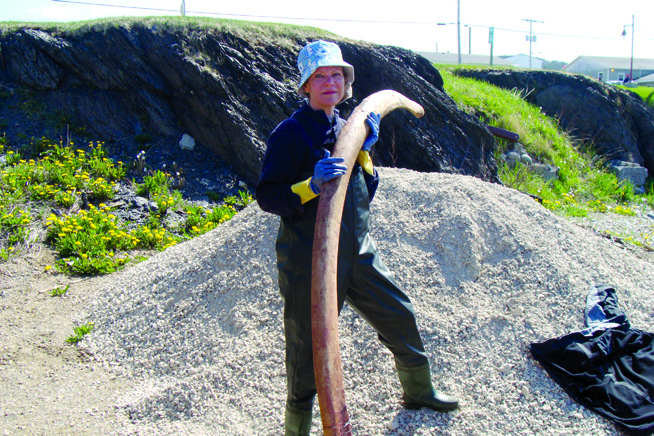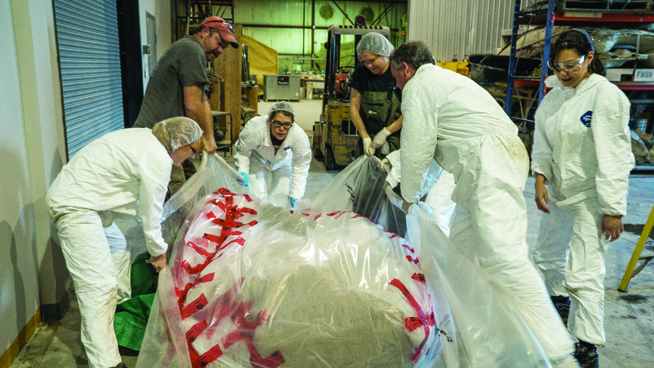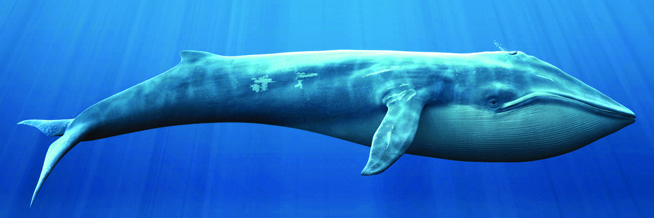Blue Whale Research

Scientific study and preservation continue for the ROM’s Blue Whale
Guest blog by Jacqueline Miller, Mammalian Technician
The blue whale is the largest animal known to have ever lived. What are the advantages to being so large? What are the disadvantages?
There are advantages to being large, especially when “large” involves specific body shapes and construction. The blue whale is not only large but also fusiform, or “torpedo-shaped.” While this shape facilitates movement, a uniform and relatively reduced surface area also allows for economy in heat regulation and a minimizing of heat loss. Although whales have a relatively high metabolic compared with than terrestrial mammals of equivalent size, their large size allows for an economy of caloric requirement: big organisms actually need less to fuel their overall metabolic needs than a comparable mass of small organisms.
Big is also an advantage when considering potential predators. Although sharks and killer whales might be a threat to newborn blue whales, there are simply no natural predators large enough to effectively hunt an adult blue whale with any efficiency.
For the blue whale, there aren’t many disadvantages to being large except finding enough food in one spot! Being extremely large might limit accessibility to shallower habitats. Also, being large in the wrong temperatures can lead to overheating. This is a problem for whales, dolphins, and porpoises that get stranded.
About how long has the blue whale been around?
A long time! This is a question science is still working on. New data is pushing toward older dates for important events in the evolutionary history of whales. Cutting-edge “total evidence” analyses now date an early adaptive radiation of both toothed and baleen whale to as early as 39 million years ago. The family to which the blue whale belongs may have evolved as early as 23 to 25 million years ago, and with this came a shift to a bulk filter-feeding.
Do we have any idea how large the blue whale population was before the advent of commercial whaling?
The historical population of the blue whale has been estimated at somewhere between 300,000 and 350,000. Between 1909 and 1965, the reported kill of the blue whales in the Antarctic alone (where commercial whaling was concentrated) was 328,177. By 1966 this number had increased to an estimated 346,000 blue whales killed. When commercial whaling of the blue whale was finally banned, it was estimated they had suffered up to a 99 percent population loss. Present estimates are between 5,000 and 10,000 in the Southern Hemisphere, and between 3,000 and 4,000 in the Northern Hemisphere. Of this, the North Atlantic population represents a tiny fragment.
What effects has commercial whaling had on the whales themselves? With moose, we have seen that a century of hunting the largest bucks (size-selective harvesting) has reduced the size of individuals by removing the larger specimens from the gene pool. Have scientists noticed similar changes in blue whales?
That’s really hard to say since so many whales perished in such a short span of time. For “trophy” animals (such as bear, moose, and elk), which have a long history of being hunted, targeting the largest animals has led to some species becoming smaller on average. The smaller animals, less impressive as trophies, are more likely to be passed over, and hence may pass on genes contributing to smaller size. We do have data for diminishing average length of whales caught in the Antarctic from 1933 to 1963, and there was a definite trend to smaller whales being taken. Size alone was the biggest factor determining the relative commercial value of a whale: the bigger the whale, the greater the profit. This trend toward smaller captures at the end of the commercial whaling era was demonstrated in all of the big rorqual species. The period of time in which this occurred, however, was short. It is more probable that fewer of the oldest animals remained, leaving only smaller, younger individuals.
This was definitely a problem during the whaling heyday as there was a period where several large species could be legally caught (based on length regulations) before many would have obtained their optimum reproductive potential. It was through research and a better understanding of whale biology that this critical problem was identified.
Looking across the large expanse of evolutionary time has led some researchers to suggest a trend to larger size for marine mammals.
What parts of a blue whale does the ROM have in its collection?
Since the skeleton and the heart are still under preparation, we actually have only some tissue samples and bone core samples in the Museum. We will have the complete skeleton, a complete plastinated heart, and most of the baleen for the upcoming exhibition. We also have a rib or partial rib in our collection that originally came to us from the University of Toronto.
What is the largest organ of a blue whale?
Many folks think the heart is the largest organ. However, the size of the heart is dwarfed by the liver, the total length and volume of the intestines, and even the tongue. The tongue alone weighs as much as if not more than an elephant!
You recently shipped off the heart from the recovered whale for plastination. Could you tell us about the process?

The process of plastination is rather complex. There are several stages, each vitally important to the outcome of the specimen. Many factors are affected by the size, dimensions, and density of your specimen also. For instance, hollow organs like the heart require a special approach, so that they are not preserved as flat or poorly defined. In general there are four stages: preservation, dehydration, impregnation, and curing.
Preservation involves the fixation of a specimen in formalin (a dilute formaldehyde). The goal is to “fix” a specimen in as close to its anatomically correct conformation as possible. You’ve likely seen through the ROM’s social media some of the images of our work during this stage with the heart, and our attempts to “reinflate” it.
After the specimen is fixed it undergoes chemical dehydration. All the water in the tissue is drawn off with either an alcohol or an acetone. Once the specimen is completely dehydrated, the specimen undergoes “impregnation” with a polymer, usually silicone, which displaces the dehydration chemicals. This process is complex and involves a balance of vacuum, temperature, and time. The specimen is then “cured” so that the polymer hardens. The result is an anatomical specimen that will last hundreds if not thousands of years, which preserves exquisite anatomical detail, often right down to the microscopic level. It is the process adopted by the Bodyworlds folks, who, incidentally, are assisting us with our blue whale’s heart.
What do you like most about this project?
I enjoyed learning new things about the blue whale’s biology the most. Since my background academically was the study of vocal behaviour in mammals, I really wish we could have the opportunity to record the blue whales off Newfoundland and Nova Scotia ourselves. That would be phenomenal! However, being the lead of the team responsible for the preservation of the heart was a fantastic, once-in-a-lifetime experience. I don’t think much could top that.
What do you dislike the most about it?
Nothing! OK, that is not entirely true. I disliked how my hair smelled after a day on site, or after a day working with the heart. The odour would really persist. I ended up obtaining a robust supply of motel-room shower caps while in Newfoundland!

Just how big is the blue whale that washed ashore in Trout River, Newfoundland?
23.3 metres (that's about the length of an 18-wheeler transport truck)
Originally published in the Spring 2016 of the ROM Magazine.
